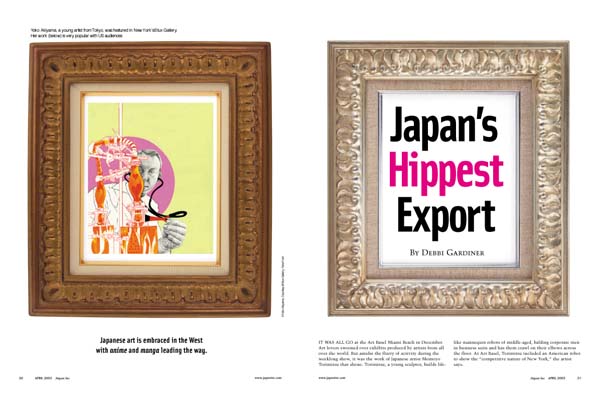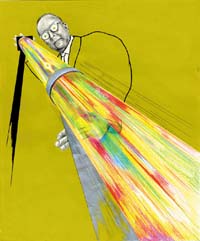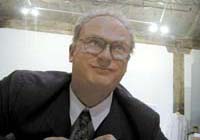Japan's Hippest Export
Back to Contents of Issue: April 2003
|
|
|
|
by Debbi Gardiner |
|
 It was all go at the Art Basel Miami Beach in December. Art lovers swooned over exhibits produced by artists from all over the world. But amidst the flurry of activity during the weeklong show, it was the work of Japanese artist Momoyo Torimitsu that shone. Torimitsu, a young sculptor, builds lifelike mannequin robots of middle-aged, balding corporate men in business suits and has them crawl on their elbows across the floor. At Art Basel, Torimitsu included an American robot to show the "competitive nature of New York," the artist says. THE MANNEQUINS WERE A hit. The Miami Herald dubbed the performance piece "the most intriguing work on display." Days later, the artist was interviewed by National Public Radio. Torimitsu is just one of several Japanese contemporary artists capturing US headlines. New York-based pop artist Takashi Murakami's designs have become very popular, too. At Christie's, the auction house, Murakami's three-panel painting, "When the Double Helix is Aroused I hear a familiar voice," sold for $427,500, more than double the house's high estimate of $200,000. In January, Murakami's updated versions of the iconic but dated line of Louis Vuitton handbags hit department stores. New York art magazines call him the "Andy Warhol of Japan." Contemporary photographer Miwa Yanagi is famous for her computer-composed photographs of subjects such as "elevator girls." The sweet, pop-oriented work of Yoko Akiyama is getting rave reviews at the Linc Real Art Gallery in San Francisco as well. In a word, Japanese art is hot.
"The prominence of Japanese contemporary and other Asian contemporary art is shifting up," says Louise Merlyn, public relations director for the Japan Society of New York and a confessed Murakami fan. "People love it." Interest in Japanese contemporary artists is so great that New York galleries have been devoting entire exhibits to their work. In February, the avant-garde P.S.1 Gallery in New York opened a three-month exhibit devoted entirely to emerging Japanese artists. In December, the Japan Society of New York opened a gallery to cater to the growing interest in Japanese art. Their shows had ample media coverage and patrons, Merlyn says, while two years ago they struggled to get exposure for their events. Part of the fascination with Japanese art, dealers say, comes from the American love affair with Japanese anime. Video-rental chains like Blockbuster are filled with anime offerings these days. In January, Hayao Miyazaki's anime fantasy, Spirited Away, won a slew of awards at the animation industry's Annie Awards. Major bookstores here like Barnes & Noble and Borders now stock manga, helping the acceptance of contemporary Japanese art. And because the work already in the US spotlight is so good, it is easier for newcomers to break in. Tim Evans is a New York painter and exhibitor who helps young Tokyo artists exhibit their work in the States. He says that thanks to Murakami and other artists like Mariko Mori and Yoshitomo Nara, who have fused old and new Japanese artistic styles, the US interest in young Japanese art is huge. Had prolific artists like Murakami not already made the stage for Japanese artists, it would be harder for newcomers to succeed, Evans says.
New York art magazines call Murakami the This large a following is unprecedented, experts say, but the Western world's fascination with Japanese art is nothing new. Take a look at work by Impressionists like Vincent Van Gogh and the love of Japanese woodblock prints is obvious, says Tatsu Yamada, a ceramic sculptor and professor at Knox College in Galesburg, Illinois. The US began really taking notice of contemporary Japanese artists in the 1960s, when non-Western cultures like China and Japan inspired new forms of artistic expression. Artists Yaoi Kusama and Yoko Ono made their big splash then. Ono was a critical part of Fluxus, an avant-garde movement in New York, and made huge contributions to conceptual art in New York, Tokyo and London, where her famous Indica Gallery exhibit took place in 1966. In the 1980s, several major exhibitions challenged the notion that Japanese contemporary art was all about soothing textures, Zen and the aesthetics of tea. There was the "Against Nature: Japanese Art in the Eighties" exhibit at the San Francisco Museum of Modern Art in 1989; "Primal Spirit," a hugely successful traveling show of contemporary Japanese sculptors soon after that; and "Japanese Art after 1945; Scream against the Sky," which showed in New York and Shizuoka and was the biggest display of Japanese modern art of its time.
It wasn't until the late 1980s, when Murakami's and pop artist Nara's works began spreading overseas, that doors were truly opened to young artists from Japan in the US. "You really saw a shift when Murakami arrived," Evans says. "His presence and success in the New York art scene gave a lot of young Japanese artists the courage to explore their cultural and historical roots and produce original work not mimicking another country's work." Since then, the interest has been growing rapidly. Murakami opened his New York studio in 1994, the same year he participated in the P.S.1 International Studio Program on a fellowship grant from the Rockefeller Foundation Asian Cultural Council. In 1997, New York's Time Out and Fortune showed Torimitsu in her nurse's uniform with her crawling salaryman robot, "Miyata Jiro," in the streets of New York. This was her first US exposure; now she is in the news regularly. Aside from bringing money and fame to young and talented Japanese artists, the recent flurry seems to have shifted the US media's take on Japan. The image of Japan as a struggling economic giant still prevails. However now this is coupled with the idea that Japan is the producer of cutting-edge art, design and fashion. "The image of Japan and Japanese art is changing," Merlyn at the New York Japan Society says. "Before, when you thought of Japan, you used to think of a businessman in a blue suit or of Hello Kitty. Now the art shows Japan as being more diverse than that." Fred Schodt is a San Francisco-based Japanese interpreter and the author of several books on manga and Japanese culture. Schodt sees the current perceptions of Japan as some of the most pleasant ever. Compared with post World War II images of Japanese as suicidal kamikaze pilots or geisha, the 1960s fascination with Zen, and the 1980s fear that worker bee Japanese would put Americans out of work, today's image is an improvement, Schodt says. "Japan's image has changed to being a provider of interesting pop culture, ideas, products and high-tech that make American lives easier," Schodt notes. Perceptions have changed so much there is almost a role reversal between the two countries. Torimitsu accepts the 1980s image of Japanese as workaholics. "It was true," she says. "Karaoke bars and hostess bars all come from that corporate culture." But now it is New Yorkers always talking about how busy they are. "People are spinning around all the time. That is my image of New York," she says. Schodt cites the misspelled kanji on Western clothes and tattooed onto the arms of muscle-bound men in San Francisco's Haight Ashbury district as an example of how perceptions of Japan have changed. "Before it was Americans laughing at the funny English on Japanese shopping bags," he says. Now it looks like Japanese contemporary art is going to the next level, and the numbers and prominence might continue to grow. At a recent Japanese art exhibit in the Stux Gallery in New York, which drew 600 people, manga panels were going for $600 a pop. American art experts see huge potential for artists such as Sayumi Yokouchi, Hiroshi Kan, Kaoru Arima, Yoko Akiyama as well as the manga artists Shinsan Nameko, Shintaro Kago and Kan Takahama, all young and new to the US. Meanwhile, the following of Murakami's work just keeps getting larger. The Serpentine Gallery in Hyde Park, London, ran an entire exhibition of his work from November through January. The amount of Japanese corporate sponsorship may be growing too. Philip Morris KK, which has been sponsoring Japanese artists since 1995, backs the Emerging Artists from Japan exhibit at the P.S.1 Gallery in New York. In a press release, President Paolo Degola said the company was committed to helping young Japanese young artists gain recognition in the international art community. New York artist Evans says it's become easier to find corporate sponsors like Japan Broadcasting Corp., better known as NHK, to fund his recent trips to Tokyo to check out the art scene.
The Japanese art that is hot right now tends to be violent, even angry-looking. Popular manga artist Kago, for instance, tackles the dark realities of academic pressure in his work. He has also addressed the issue of homelessness. Nameko deals with female issues such as diet fads. "It's great to see an artist make a political stand and make comments," Evans says.
Torimitsu accepts the 1980s image of Japanese as workaholics. Yamada, the ceramic artist and professor, says it is the radical side of Japan and Japanese art that Americans like. Murakami once told a journalist who had complimented him on his upbeat messages: "If my art looks positive and cheerful, I would doubt it would be accepted in the contemporary art scene. My art is not pop art. It is a record of the struggle of the discriminated people." As long as it is easier to make a name in the States than in Tokyo, young artists are bound to continue catering to American consumers. Artists say the chances of getting exposure in Tokyo before they are in their 40s or 50s is unlikely given the nature of Japanese society, which requires people to pay their dues. And whereas US galleries approach graduate students, in Japan, young artists have to grovel to get an exhibit. "For young artists to see their work sell here and see Americans enjoy it is a huge confidence boost," Evans says. That's fine. But for the artists not interested in manga, anime or expounding on the underbelly of Japanese society, diet pills and oppression of women, it might be difficult to find a niche. One scholar of Japanese art history on the West Coast says he knows several artists who struggle to find a place for their work in the US. The scholar, who wishes to remain anonymous, is skeptical about just how much the mass media cares about Japanese art. "I worry when undergraduates in my classes perceive Japan as anime, and the larger tendency to form totalistic impressions based on the fame of a few artists," he says.
Others don't have a problem with the darker images; they think the Japanese work getting noticed in the States is still too light. Evans says looking at Murakami's manga, for instance, Japan could be considered a puffy, shiny, simple place, when it's not like that at all. "Japan is the most complex place I know. It is the new, younger artists who probe deeply into that." @ Deb Gardiner is a Miami-based freelance writer, a former Japan resident, and a frequent contributor to J@pan Inc.
|
|
Note: The function "email this page" is currently not supported for this page.



 Some artists are starting to expand their focus. Torimitsu has shifted her interest to international corporate culture since living in New York. "That is more interesting to me," she says. There is an American, European and Asian corporate robot and, if she can get the clearance, her next project will be filming them racing one another in the foyer of a nice New York building. "It will be like an international car race," she says.
Some artists are starting to expand their focus. Torimitsu has shifted her interest to international corporate culture since living in New York. "That is more interesting to me," she says. There is an American, European and Asian corporate robot and, if she can get the clearance, her next project will be filming them racing one another in the foyer of a nice New York building. "It will be like an international car race," she says.




